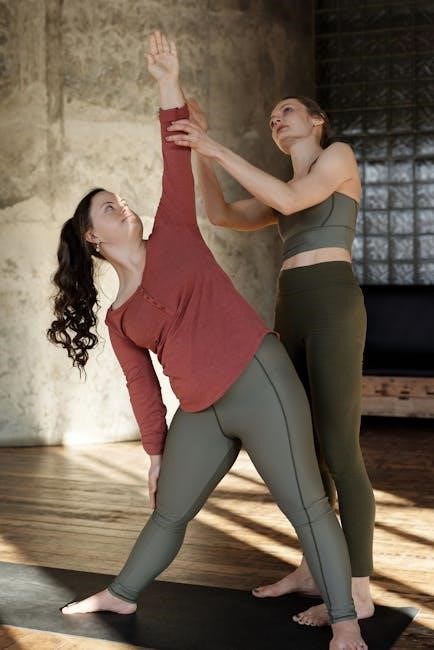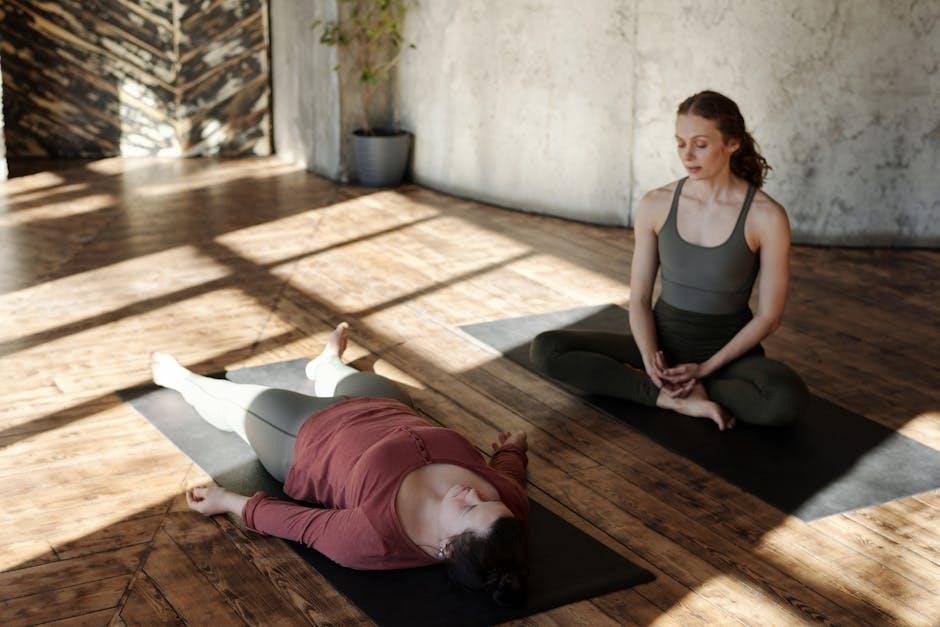yoga teachers instruction crossword
A yoga teachers instruction crossword combines yoga knowledge with puzzle-solving, engaging both mind and body. It helps teachers refine their understanding of poses, breathing techniques, and philosophy, making learning interactive and fun. This unique tool bridges education and relaxation, offering a creative way to deepen yoga expertise while enjoying a challenging yet rewarding activity.
1.1 Overview of the Crossword Puzzle
A yoga teachers instruction crossword is an engaging tool designed to test and expand knowledge of yoga-related terms, poses, and concepts. It typically features a grid filled with clues related to yoga, such as asanas, breathing techniques, and philosophical terms. The puzzle is structured to challenge both novice and experienced yoga practitioners, offering a fun and educational experience. By incorporating elements like word roots and symmetry, it encourages critical thinking and problem-solving skills. This crossword is particularly useful for yoga teachers, as it helps them refine their understanding of key instructions and terminology, ensuring they can communicate effectively with students. It also serves as a creative way to reinforce learning and prepare for class instruction. Additionally, solving the crossword can be a relaxing and mentally stimulating activity, aligning with the mindfulness principles of yoga itself. Its popularity has grown as a unique blend of education and entertainment, making it a valuable resource for yoga enthusiasts and educators alike.
1.2 Importance of Yoga Instructions in Crosswords
Yoga instructions in crosswords play a vital role in enhancing understanding and recall of key yoga concepts. By incorporating poses, breathing techniques, and philosophical terms, these puzzles help yoga teachers and practitioners alike refine their knowledge. The clues often require precise terminology, ensuring accuracy and attention to detail. This focus on specific instructions aids in improving communication skills, as teachers can better articulate poses and sequences to students. Additionally, solving these crosswords reinforces memory retention of yoga-related vocabulary, making it easier to apply in real-world teaching scenarios. The mental engagement also aligns with yoga’s mindfulness principles, fostering a calm and focused state. Overall, yoga instructions in crosswords serve as a practical and enjoyable tool for professional development and continuous learning in the field of yoga instruction.

Understanding Yoga Instruction Clues
Yoga instruction clues in crosswords test knowledge of poses, breathing techniques, and philosophical terms. They often require precise terminology, including Sanskrit names, adding complexity and depth to puzzles.
2.1 Common Yoga Poses as Clues
Common yoga poses often feature as clues in crosswords, challenging solvers to identify names like “Downward Dog” or “Warrior.” These clues may ask for the pose’s Sanskrit name, such as “Vrksasana” for Tree Pose, or its English equivalent. Crosswords frequently include poses like “Child’s Pose” (Balasana) or “Plank” (Phalakasana), testing knowledge of both basic and advanced asanas. Some clues might hint at the pose’s type, such as “standing pose” for “Tadasana” or “seated forward bend” for “Paschimottanasana.” These clues not only test yoga vocabulary but also encourage solvers to think critically about the poses’ meanings and classifications. For yoga enthusiasts, these clues add an engaging layer of familiarity and challenge to the puzzle.
2.2 Breathing Techniques as Crossword Clues
Breathing techniques, or Pranayama, often appear as crossword clues, challenging solvers to identify terms like “Ujjayi” (ocean breath) or “Kapalabhati” (breath of fire). Clues might ask for the Sanskrit name or its English translation, such as “Alternate Nostril Breathing” for “Nadi Shodhana.” These clues test knowledge of yoga’s respiratory practices, which are essential for balancing energy and calming the mind. Some crosswords include hints like “breathing technique for relaxation” or “energizing breath practice,” requiring solvers to think about the purpose and benefits of each method. By incorporating such clues, crosswords help yoga enthusiasts deepen their understanding of these vital techniques while enhancing their problem-solving skills in a fun and engaging way. This adds a unique dimension to the puzzle-solving experience.
2.3 Yoga Philosophy Terms in Crosswords
Yoga philosophy terms often appear as crossword clues, introducing solvers to concepts like “Ahimsa” (non-violence) or “Dharma” (duty). Clues might reference the Eight Limbs of Yoga or the “Yamas and Niyamas,” challenging solvers to recall these foundational principles. Terms like “Moksha” (liberation) or “Samadhi” (union with the divine) require knowledge of Sanskrit and their philosophical meanings. These clues not only test vocabulary but also deepen understanding of yoga’s ethical and spiritual dimensions. By incorporating such terms, crosswords serve as a learning tool, helping yoga teachers and enthusiasts alike to engage with the rich philosophical underpinnings of the practice. This makes crosswords a unique and educational resource for those exploring yoga’s deeper teachings.

Solving Strategies for Yoga Teachers Instruction Crossword
Start with familiar yoga terms, use word roots, and look for common patterns. This approach helps in quickly filling the grid and completing the puzzle effectively.
3.1 Breaking Down Complex Clues
Breaking down complex clues in a yoga teachers instruction crossword involves identifying key components and analyzing word lengths. Start by pinpointing the main theme or category, such as a specific pose or breathing technique. Next, look for common prefixes or suffixes that hint at the answer. For example, Sanskrit roots like “vira” (hero) or “bhujang” (snake) are often used in yoga terms. Use process of elimination by cross-referencing intersecting words. Focus on filling in shorter answers first, as they often provide clarity for longer, more intricate clues. Pay attention to wordplay, puns, or layered meanings, which are common in crossword puzzles. By systematically dissecting each clue, you can unlock even the most challenging entries and progress through the puzzle with confidence.
3.2 Using Word Roots and Prefixes
Using word roots and prefixes is a powerful strategy for solving yoga teachers instruction crosswords. Many yoga-related terms originate from Sanskrit, and recognizing common roots can help decipher clues. For example, the prefix “a-” often denotes “without” (e;g., “asana” means “posture”), while “surya” refers to the sun, commonly seen in “surya namaskar” (sun salutation). Similarly, prefixes like “eka” (one) or “dvi” (two) are frequently used in pose names. By identifying these patterns, you can narrow down possible answers and fill in the crossword more efficiently. This approach also enhances vocabulary retention, as understanding word origins makes terms more memorable. Leveraging roots and prefixes is especially helpful for longer, more complex clues, making it a valuable tool for both novice and experienced solvers alike.
3.3 Crossword Patterns and Symmetry
Crossword patterns and symmetry play a crucial role in solving yoga teachers instruction crosswords. Many crosswords follow a symmetrical grid design, where clues overlap both horizontally and vertically, creating a balanced structure. Recognizing these patterns can help solvers anticipate word lengths and intersections, making it easier to fill in blanks. For yoga-themed crosswords, common patterns include repeated use of pose names, breathing techniques, and philosophical terms. Symmetry also ensures that clues are evenly distributed, offering a visually appealing challenge. By studying the grid’s layout and identifying recurring word lengths, solvers can more effectively navigate complex puzzles. This strategic approach not only aids in solving but also enhances the overall enjoyment of the crossword experience for yoga enthusiasts and teachers alike.

Popular Yoga-Related Crossword Answers
Popular yoga crossword answers include common poses like “Vinyasa” and “Salute,” breathing techniques like “Pranayama,” and terms like “Asana” and “Namaste.” These words frequently appear in puzzles.
4.1 Common 5-Letter Answers
Common 5-letter answers in yoga crosswords include “Vinyasa,” “Salute,” “Prana,” “Asana,” and “Yamas.” These terms are frequently used in yoga instruction and often appear in puzzles. They relate to various aspects of yoga, such as poses, breathing techniques, and ethical principles. For example, “Vinyasa” refers to a flowing sequence of movements, while “Yamas” are ethical guidelines. These concise terms make them ideal for crossword clues, providing a balance between challenge and solvability. They also help reinforce knowledge of key yoga concepts for both teachers and practitioners. These 5-letter words are essential for anyone creating or solving yoga-themed crosswords, ensuring a fun and educational experience.
4.2 Longest Yoga-Related Crossword Answers
The longest yoga-related crossword answers often include complex terms or phrases. For example, “Surya Namaskar” (sun salutation) is a 13-letter answer, making it a challenging yet educational clue. Other lengthy terms include “Navasana” (boat pose) at 8 letters and “Sirsasana” (headstand) at 9 letters. These longer answers provide depth to crosswords, testing solvers’ knowledge of advanced yoga concepts. They also highlight the diversity of yoga terminology, from poses to breathing techniques. Including such terms encourages solvers to explore and learn more about yoga’s rich vocabulary. These longer answers add complexity and educational value to crossword puzzles, making them both fun and intellectually stimulating for yoga enthusiasts and teachers alike. They often serve as standout clues in a puzzle, rewarding those with extensive yoga knowledge.
4.3 Most Frequently Used Terms
In yoga teachers’ instruction crosswords, certain terms appear more frequently due to their common usage in practice and instruction. Words like Vinyasa, Asana, and Pranayama are staples, referring to sequences, poses, and breathing techniques. Terms like Namaste and Om are also prevalent, reflecting yoga’s philosophical roots. These terms are often short and recognizable, making them ideal for crossword clues. Additionally, terms like Downward Dog (Adho Mukha Svanasana) and Cobra Pose (Bhujangasana) are frequently used, as they are foundational poses in many classes. These terms not only test solvers’ knowledge but also reinforce common yoga vocabulary, making crosswords a valuable tool for both teachers and practitioners to engage with yoga terminology in a fun and educational way. Their repetition ensures they remain memorable and relevant in the context of yoga instruction.

Benefits of Yoga Crosswords for Teachers
Yoga crosswords enhance teachers’ vocabulary, improve cognitive function, and reduce stress through engaging puzzle-solving. They also promote mental clarity and focus, benefiting both personal and professional growth effectively.
5.1 Enhancing Vocabulary Related to Yoga
Engaging with yoga crosswords is an effective way to expand and refine yoga-related vocabulary. By solving clues related to poses, breathing techniques, and philosophical concepts, teachers can deepen their understanding of yoga terminology. Crosswords introduce new words while reinforcing familiar ones, making them a valuable tool for both seasoned instructors and those new to yoga. The interactive nature of crosswords makes learning enjoyable and challenging, helping teachers communicate more effectively with students. Over time, this mental exercise enhances recall and precision, ensuring a stronger command of yoga concepts. Whether it’s a pose name or a philosophical term, crosswords provide a fun and engaging way to build a robust yoga vocabulary.
5.2 Improving Cognitive Function
Engaging in yoga crosswords offers significant cognitive benefits, particularly for yoga teachers. Solving clues requires critical thinking, memory recall, and focus, which sharpens mental acuity. Regularly tackling crosswords can improve problem-solving skills, enhance concentration, and boost overall brain function. The process of deciphering clues related to yoga poses, breathing techniques, and philosophical terms stimulates the mind, fostering mental agility. This cognitive exercise not only enhances teaching preparation but also improves the ability to articulate complex yoga concepts clearly. By challenging the brain in a structured yet enjoyable way, yoga crosswords serve as a powerful tool for maintaining and improving cognitive health, which is essential for effective teaching and communication.
5.3 Reducing Stress Through Puzzle Solving
Engaging in yoga crosswords can be a therapeutic activity for teachers, offering a healthy escape from daily stress. The focused nature of solving clues distracts the mind from pressures, promoting relaxation. Much like yoga, the mental exercise of crosswords encourages mindfulness and calmness. By immersing oneself in the puzzle, teachers can unwind and recharge, creating a meditative state that reduces anxiety. This stress-relieving benefit aligns with yoga’s principles of balance and well-being, making crosswords a complementary tool for maintaining emotional and mental harmony. Regular puzzle solving can enhance resilience, helping teachers manage their workload more effectively while fostering a sense of accomplishment and joy.

Yoga Crosswords as a Learning Tool
Yoga crosswords serve as an engaging educational resource, making learning interactive and fun while reinforcing key yoga terminology and concepts for both teachers and students alike.
6.1 Teaching Yoga Through Crosswords
Yoga crosswords offer a dynamic way to teach yoga concepts, engaging students with interactive puzzles that introduce poses, breathing techniques, and philosophical terms. By integrating crossword puzzles into lessons, teachers can make learning fun and accessible, ensuring students retain information effectively. Crosswords cater to visual and logical learners, fostering a deeper understanding of yoga terminology and principles. They also encourage critical thinking and problem-solving skills, aligning with the mindful nature of yoga. Teachers can customize puzzles to focus on specific themes, such as asanas, pranayama, or the Eightfold Path, creating a tailored learning experience. This approach not only enhances engagement but also reinforces key concepts, making it a valuable educational tool for yoga classes.
6.2 Engaging Students with Interactive Puzzles
Interactive yoga crosswords captivate students by transforming learning into a game-like experience, fostering engagement and enthusiasm. These puzzles not only test knowledge but also encourage active participation, making complex concepts more approachable. Students enjoy the challenge of solving clues related to yoga poses, breathing techniques, and philosophy, which enhances their retention of the material. The competitive aspect of crosswords can motivate students to delve deeper into their studies, while collaborative solving fosters teamwork and communication. This interactive method aligns with modern educational strategies, providing a refreshing alternative to traditional teaching methods and keeping students thoroughly involved in the learning process. As a result, interactive puzzles become a valuable asset in yoga education, promoting both fun and understanding;
6.3 Reinforcing Yoga Terminology
Yoga crosswords serve as an effective tool for reinforcing yoga terminology, helping students and teachers alike to commit key terms to memory. By repeatedly encountering and solving clues related to poses, breathing techniques, and philosophical concepts, individuals strengthen their understanding and retention of essential vocabulary. The interactive nature of crosswords makes learning more engaging and dynamic, allowing users to associate words with their meanings in a fun and challenging way. This method not only enhances familiarity with yoga-related terms but also encourages a deeper connection to the practice, making it easier to recall and apply the terminology in real-world teaching and learning scenarios. Over time, this consistent exposure fosters a robust foundation in yoga knowledge that is both practical and enduring.

Tips for Creating Yoga Instruction Crosswords
Select relevant yoga terms, design a balanced grid, and ensure clues are accurate. Use clear instructions and vary difficulty to engage both beginners and advanced solvers effectively.
7.1 Selecting Relevant Yoga Terms
When creating a yoga instruction crossword, it’s crucial to select terms that resonate with both yoga teachers and enthusiasts. Start by compiling a list of common yoga poses (asanas), breathing techniques (pranayama), and philosophical concepts. Include terms like “Downward Dog,” “Child’s Pose,” “Vinyasa,” and “Namaste” to ensure relevance. Consider varying difficulty levels by mixing basic poses with more complex ones. Additionally, incorporate Sanskrit terms to add depth and authenticity. Ensure the selected words align with the target audience’s knowledge level, whether they are beginners or advanced practitioners. This careful curation ensures the crossword is both educational and engaging, making it a valuable tool for yoga instructors and students alike.
7.2 Designing Grid Patterns
Designing grid patterns for a yoga teachers instruction crossword involves careful planning to ensure a balance between functionality and aesthetics. Start by selecting a square grid size, such as 15×15, to accommodate a variety of yoga-related terms. Symmetry is key, so opt for a traditional symmetrical design to maintain balance and solvability. Strategically place black squares to segment the grid without isolating sections, creating a natural flow. Consider adding thematic elements, like a lotus or om symbol, using black squares to enhance visual appeal. Allow words to flow horizontally, vertically, and diagonally to represent yoga’s fluid movements. Begin with familiar terms like “Namaste” or “Begin” to set a welcoming tone. Use color coding to distinguish sections, such as green for nature or blue for calmness. Finally, test the grid with yoga teachers to refine its challenge and enjoyment, ensuring it educates and engages effectively.

7.3 Ensuring Clue Accuracy
Ensuring clue accuracy is crucial for creating a yoga teachers instruction crossword that is both educational and enjoyable. Start by verifying each clue against reliable yoga resources, such as textbooks or expert opinions, to avoid misinformation. Cross-reference terms with their Sanskrit names and meanings to maintain authenticity. For example, confirm that “Vrksasana” correctly translates to “Tree Pose.” Use online databases and crossword solvers to check for common clues and avoid redundancy. Additionally, test clues with experienced yoga instructors to ensure they are challenging yet solvable. Clear and concise language is essential to prevent ambiguity, making the crossword accessible to both novice and advanced practitioners. By prioritizing accuracy, the crossword becomes a valuable tool for learning and reinforcing yoga terminology effectively.

Popularity of Yoga Crosswords in Modern Wellness
Yoga crosswords are gaining traction as a mindful activity, blending relaxation with cognitive stimulation. They appeal to wellness enthusiasts seeking to combine mental exercise with spiritual practices, fostering calm focus and deeper yoga knowledge while engaging communities in shared, meditative problem-solving experiences.
8.1 Rise of Yoga-Themed Puzzles
The rise of yoga-themed puzzles reflects the growing interest in wellness and mindfulness. Crosswords centered around yoga themes have become popular as they cater to both yoga enthusiasts and puzzle lovers. These puzzles often feature terms related to yoga poses, breathing techniques, and philosophical concepts, making them a unique way to engage with yoga knowledge. The increasing popularity of yoga in modern culture has led to a demand for such interactive tools, providing a fun and educational way to explore yoga terminology. As a result, yoga-themed crosswords are now widely available in wellness magazines and online platforms, attracting a diverse audience seeking mental and spiritual enrichment.
8.2 Integration with Mindfulness Practices
Yoga-themed crosswords are increasingly integrated with mindfulness practices, offering a unique way to combine mental focus and relaxation. Solving these puzzles requires concentration and calmness, mirroring the meditative state achieved in yoga. The process of deciphering clues and fitting words into a grid encourages presence and patience, similar to mindfulness exercises. This integration enhances the overall wellness experience, as participants engage both their minds and bodies; The combination of yoga terminology and puzzle-solving creates a holistic activity that promotes mental clarity and emotional balance. Thus, yoga crosswords serve as a modern tool for fostering mindfulness while deepening one’s understanding of yoga principles. They are a perfect blend of intellectual challenge and spiritual growth, appealing to those seeking a mindful and enriching pastime.
8.3 Community Engagement Through Crosswords
Yoga crosswords foster community engagement by providing a shared activity that connects individuals with a common interest in yoga and puzzle-solving. Studios and wellness centers often use these crosswords as group exercises, encouraging participants to collaborate and learn together. The shared goal of completing the puzzle creates a sense of camaraderie, breaking down barriers and fostering connections. Online platforms further amplify this by allowing global participation, where users can share solutions and insights. This collective engagement not only strengthens community bonds but also promotes a supportive environment for learning and growth. By leveraging the universal appeal of crosswords, yoga communities can unite people worldwide, creating a shared space for both mental and spiritual enrichment.
Yoga crosswords offer a unique blend of mental stimulation and spiritual growth, providing teachers and enthusiasts alike with a transformative tool for learning and relaxation.
9.1 Summary of Key Points
Yoga teachers instruction crosswords are engaging tools that enhance vocabulary, cognitive function, and stress reduction. They incorporate poses, breathing techniques, and philosophy, offering a fun way to deepen yoga knowledge. Solving strategies, such as breaking down clues and using word roots, improve problem-solving skills. Popular terms like “vinyasa” and “pranayama” frequently appear, aiding in terminology reinforcement. These crosswords serve as both educational resources and mindfulness exercises, fostering a deeper connection to yoga principles. By combining mental stimulation with spiritual concepts, they provide a holistic learning experience for teachers and enthusiasts alike, making them invaluable for both personal growth and instructional purposes.
